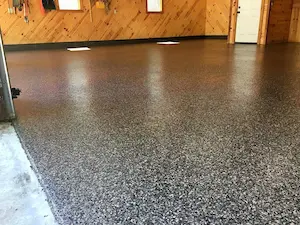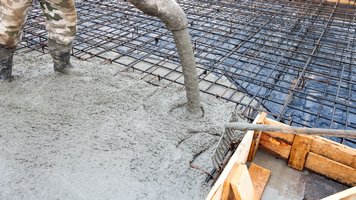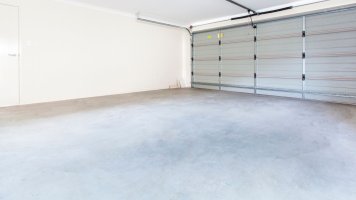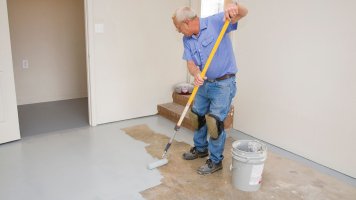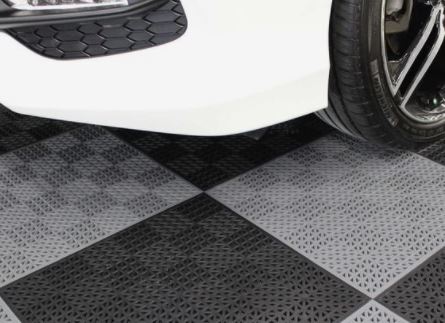Garage Flooring Guide: Sealing (How it Works, Benefits)
This post contains affiliate links.
You might have heard about concrete sealers or have seen beautifully glossy concrete floors somewhere. There are many types of concrete sealers and much to know before considering the project onto your floors. We take a look at different sealers and help you make the proper choice suited for your needs.
Sealing the concrete protects it from water,freeze-thaw, dirt, oil, chemicals, mold, U.V., road salt, and wearing & tearing. Sealing also adds durability, longevity and prevents concrete dust. Sealing can also enhance the look of the floor and even change the color with stains/dyes.
We also look at how to apply concrete sealers and how much the project will cost, among other essential things to know about sealers.
Should I Seal My Concrete Garage Floor?
Concrete should be sealed because of the many benefits that will come with the sealing, like:
- Added durability.
- Protection from almost anything you throw at it.
- Added longevity.
- Prevent concrete dust.
- Prevent moisture.
- Enhanced look.
- Different color options.
- Prevent cracking and peeling.
- Easy and fast installation.
- There is a wide range of sealers available for any purpose.
- Sealing is cost-effective compared to fixing the concrete.
- Gloss level is customizable, or you can choose a no-gloss finish.
Does Garage Concrete Floor Need to Be Sealed?
Concrete floors do not need to be sealed. You can leave them unsealed. But concrete floors benefit significantly from sealing.
Concrete is porous and will suck in everything you, your vehicles, or mother nature throws at it. In freeze-thaw climates, the expansion of frozen water can damage the unsealed concrete surface.
Pros and Cons of Sealing Garage Floor
There are many benefits and a few drawbacks to sealing the concrete floor. Let’s look at each one.
Pros:
Mold Prevention – Concrete is porous, so it sucks the moisture right in. With moisture, you quickly get mold and mildew growth. Sealing the concrete prevents moisture from getting on the floor.
Increase Durability – Sealing the concrete will protect the floor from ice-thaw, cracking, peeling, staining, and other common problems with the concrete floor. Prevent premature damage to the floor by sealing the concrete.
Extended Longevity – Sealing the concrete extends the floor lifetime significantly longer, and you have an easier time maintaining the floor. Sealing and regular resealing the floor when necessary extend the floor durability up to +30 years.
Protection of the Floor – Sealants protect the concrete floor from the damage of water, oil, U.V. rays, freeze-thaw, mold, and everything else you or mother nature throws at them.
Color Protection – If you choose to stain the concrete with some color to change the look of the floor. Then sealing of the floor is necessary to maintain that color.
Concrete Dust – Unsealed concrete produces lots of concrete dust you have to clean up from everywhere. Sealing the concrete prevents dust from forming.
Easy and Fast Installation – A wide range of sealers is available for any purpose, and most are easy to install.
Cons:
Slippery When Wet – Some sealers become slippery when wet. You can prevent this by adding grit particles to the top layer of the sealant.
Maintenance – Sealers need to be reapplied every now and then. The time range can be 1-8 years, depending on the sealant and usage of the floor.
How Can You Tell if Concrete Is Sealed?
This varies by the type of sealer used. Chemical sealers penetrate the concrete and are nearly invisible. Any sealers with matte and flat finish can also be seen when they are fully dry. Sealers with tint change the color of the floor.
A glossy wet look is a sure way to know instantly that concrete is sealed.
- Water-based acrylic resin sealers provide moderate color enhancements. They are available in matte and satin appearance.
- Solvent-based acrylic resin sealers and epoxies provide significant color enhancements with a glossy and wet look of the concrete. The amount of gloss varies and is customizable. Available also in matte.
- Urethane sealers are applied as a topcoat over the epoxy and are available in many finishes.
Xylene Test: Use xylene to treat a small area of the concrete. Allow the xylene to sit for 20-30 seconds and then scrape the concrete. You can make a test to know if a solvent-based sealer was used. Sealants made of solvents will gum up and become sticky. Water based sealants won’t.
When Should I Seal My Concrete Garage Floor?
Concrete can be sealed anytime. But with old floors in poor condition, proper precautions like etching or grinding away the surface of the floor’s topcoat are necessary before a sealer is applied.
Most penetrating sealers and acrylic resin sealers can be applied as soon as it is safe to walk on the new floor. Reactive sealers should only be applied after 28 days when the concrete is fully cured.
28 days old concrete is a safe limit to apply any sealer.
What Type of Sealer to Choose for Your Garage Floor?
Are you thinking about what’s the best sealer for my garage floor? Well, it really depends on many factors such as:
- Are you going to DIY or hire a contractor?
- How much money are you willing to spend?
- Does the appearance of the floor matter?
- How do you plan to use your garage?
- Can you get your stuff elsewhere for a little while till the sealer or coating cures?
If you are looking for maximum quality, durability, and appearance, the best sealers are multi-coat epoxy and polyurethane. These offer the best performance and protection of the garage floor with amazing looks. They provide protection against water, dirt, stains, road salt, oil, gasoline, and other chemicals.
But there is a downside. Epoxy and polyurethane are expensive and sometimes difficult to install DIY. Contractors will charge by the hour and square foot for installation. Multi-coat epoxy also takes around 4 days to install. Polyaspartic can be installed in one day, returning your garage to full usage the next day, but they usually require professional installation. Epoxy paint kits typically only last a few years.
Acrylic Sealers – are applied to bare concrete, and you can get that glossy look. It also provides moderate protection against stains, oil, chemicals, and water. The surface is walkable in a few hours and drivable on next day. Most acrylic sealers have to be reapplied every 2 years. A gallon will cost you only $30-$40.
Penetrating Sealers – are good if you don’t mind the look of bare concrete. Installation and cost are similar to acrylic sealers. These will last years without the need for resealing. You also get some slip protection as bare concrete. This type of sealer protects against concrete dust, road salt, and spalling.
Concrete Densifiers – This type of sealant fills the concrete’s surface pores, making it stronger and denser, creating a layer that most liquids cannot penetrate. Straightforward application.
How Will the Sealed Floor Look? – Most penetrating sealers are nearly invisible. Solvent-based acrylic and epoxies enhance the look great with colors and a high gloss wet look. Water-based acrylic provides moderate color enhancement and a satin appearance. Urethanes are available from matte to gloss finishes.
Choose the sealant based on your personal needs. Take little time and choose the best option suited to your garage. Make compromises if the budget is a concern.
If You Have Moisture Issues Coming up Through the Concrete – Choose a penetrating floor sealer. Penetrating sealers breathe and can reduce moisture coming up the slab. Topical sealers and epoxy, polyurethane, and polyurea will not allow the moisture to transfer. If the moisture gets trapped under the coating, it can ruin the floor and the coating badly.
If you suspect moisture in the slab. (you have white powder residue areas in the floor that always comes back after cleaning) Then there is Efflorescence going on in the slab. or just regular damp regions.)
Conduct a moisture test – by cutting a piece of plastic sheet and taping it around with duct tape to the floor. Let it sit 24-48 hours and look for signs of condensation under the plastic or dark spot on the surface of the concrete. If there is no moisture, things should be ok with the slab. If there is moisture, do a calcium chloride test to find about how much moisture you have.
Metal Workshop – Use penetrating sealers. Most topical coatings get damaged from sharp metal bits and hot welding slag and grinding.
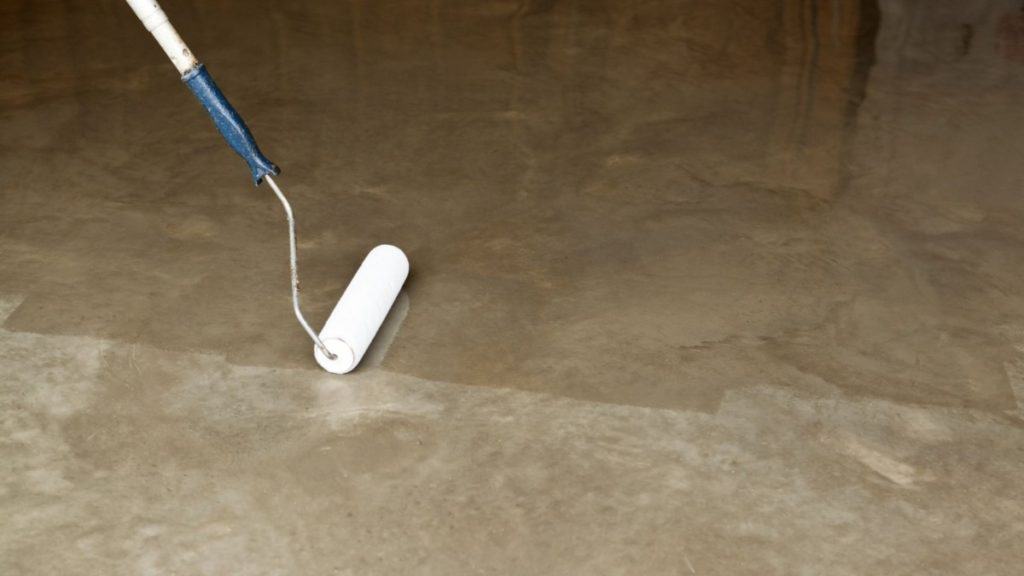
Penetrating Concrete Sealers vs. Topical Sealers
There are 3 main types of sealers. Each sealer behaves differently.
Topical Sealers – Forms a coating at the surface of the concrete floor and forms a protective layer that is non-breathable and can be impermeable depending on the sealant. These prevent the concrete from being stained by oil or other chemicals and make cleaning the floor a breeze. Used indoors and outdoors generally. Thickness, chemical resistance, and abrasive properties vary. Clear coatings enhance and darken the look of the concrete. These have a wide range of finishes, from matte to high gloss finish. Clear coating sealers are used with stained or dyed concrete.
Penetrating Sealers – Penetrates the concrete and forms a chemical barrier at the subsurface that shields the floor against moisture, among other things. These are breathable and do not form a coating on top of the surface. Does not change the look of the concrete. Retains the same wet slip resistance of the floor. Easy to apply and cheap. This type of sealant is not water or stain-proof. However, it will repel water and other fluids common in the garage environment. Penetrating sealers give you time to clean oil and chemical spills before they form a permanent stain.
Integral Sealers – Mixed into the concrete before it’s poured so the floor seals at the same time when the concrete cures.
Penetrating Sealers for Garage Floors
There is a wide range of penetrating sealers to choose from. Some are water-based, and some are solvent-based. All these are suitable for garage or workshop floors.
Siliconate Sealers
Good general protector for concrete. All-purpose sealer and great value with easy application. Provides good repellant from water, freeze-thaw, road salt, and dirt. Does not repel oil if the oil is allowed to sit too long.
Densifier Sealers
Increases the density, strength, and hardness of the subsurface of the concrete filling the pores near the surface. Does not repel water or other liquids usually. There are some with siliconate mixed in to provide liquid repelling properties. The application requires little work, so the densifier does not puddle.
Oil Repelling Sealers
Designed to repel oil just like the name says. Prevents other chemicals too. Easy to clean. Cost more than other penetrating sealers. Suitable for auto-shops and similar usage.
Topical Sealers for Garage Floors
There is a large selection of topical sealers and floor coatings available. Performance and durability vary.
Acrylic Sealers
This type of sealer forms a thin protective layer on top of the concrete. There are clear and color-tinted options. The floor will look wet and glossy though there are matte finishes too. Provides light to moderate protection from fluids of any kind. Most have U.V. protection. Solvent-based are more tough than water-based. Easy to apply. Etching is not usually required, but this depends on the existing floor condition. Reapplication may be required every 3 years, depending on the sealer.
Modified Acrylic Polyurethane Sealers
Has high performance and easy application at a low price. No etching is usually required and has U.V. protection. Has good abrasion, chemical, and stain resistance and is suitable for most garage and workshop floors. Not recommended for rough floors or concrete with numerous repairs.
Epoxy Sealers
Epoxy is a very popular garage floor sealer/coating. Has superior strength and durability compared to most normal sealers.
Read all about epoxy floors in this article.
Moisture Cured Direct to Concrete Polyurethane Sealers
High-performance coating. Abrasion and scratch-resistant. Provides chemical and stain resistance and is U.V. shielded. Forms a thin layer, so the floor should be very smooth.
Polyurea & Polyaspartic Sealers
U.V. Stable, Similar finish to epoxy and polyurethane-coated floors. It can be applied in extreme temperatures. Most need professional installation due to very short working time. There are some polyurea sealers for DIY purposes that have a longer installation time.
Gloss Levels of Concrete Floor Sealing
Concrete sealers are available with different gloss or shine levels. There are:
- No-gloss.
- Matte.
- Satin.
- Semi-Gloss.
- Gloss.
- High Gloss.
Manufacturers categorize glosses on a scale of 1-100.
100 is the highest level of gloss.
Solvent-Based Sealers: Gloss level of 80-100 produces a gloss to a high gloss finish.
Water-Based Sealers – Gloss level of 50-80 produces a matte or semi-gloss finish.
Penetrating Sealers – Gloss level of 0. Produces a no-gloss finish.
Which Is Better: Water or Solvent Based Concrete Sealer?
There are water and solvent-based concrete sealers, and you may be wondering which is a better choice for your project.
Water-based concrete sealers are an excellent option for DIY projects because of their ease of application, low VOC content, and odor. Solvent-based concrete sealers are better for commercial and professional usage.
There are pros and cons to each type of sealer. Though both are excellent at protecting concrete.
Water-Based Concrete Sealers
| PROS | CONS |
|---|---|
| Safe for people and the environment | Can be difficult to remove in some cases |
| A more natural look without darkening of the surfaces | Freezes quicker compared to solvent-based concrete sealers |
| Best for decorative concrete floors | should not be applied in temperatures below 50F |
| Low VOC (volatile organic compound) content | It may appear milky temporarily when exposed to wet weather for long periods of time but will dry up to clear once again |
| Low risk of common sealer problems such as roller marks and bubbling | |
| Can last longer in some cases | |
| Can be used inside or outside with no issues | |
| More cost-effective | |
| Easy to clean up and wash | |
| Ideal for porous and extremely dense surfaces | |
| Safe for children and pets |
Solvent Based Concrete Sealers
| PROS | CONS |
|---|---|
| A higher gloss can enhance the look of surfaces, especially with polyurethane and epoxy coats | Can get slippery when wet |
| Penetrates deeper in polished and dense concrete surfaces | Strong fumes when installing |
| Lasts long | Evaporates quickly in hot weather when installing |
| Darkens the surfaces If needed | Requires usage of protective equipment when installing |
Water-Based vs. Solvent Based Concrete Sealer
Let’s look more closely at the differences.
Appearance – Solvent-based sealers usually have a glossy finish giving that wet look of the concrete. The darker color hides stains better. Water-based sealers won’t change the color darker usually. Though there are exceptions.
Protection – Both types of sealers offer protection up to 3 years, depending on the usage of the floor. Re-sealing is often necessary after a certain time period.
Application – There are ready-to-apply formulas for spray and roller application for both types of sealants.
Water-based sealants are nonflammable, easy to clean up when done, and don’t produce a strong odor during installation.
Solvent-based sealants are flammable and produce a lot of VOC during application. The area should be well ventilated during installation.
Slippery – Solvent-based sealers can be slippery when wet because they usually form a thick layer on top of the concrete. You can add anti-slip properties with a grit traction additive, though. Water-based sealants form a very thin layer and are not usually slippery.
Coverage – With water-based sealants, you have more coverage. Solvent-based are designed to be thick. So you have less bang for a buck.
Longevity – Solvent-based sealants typically last longer than water-based. Both types of sealers should last at least 1-3 years, depending on the usage of the floor.
How Do You Prep Concrete Floor for Sealing?
Prepping the concrete for sealant takes little elbow grease, and depending on if the floor is new or old, you have to take different steps. With new floors, the job is more straightforward.
First, start off by cleaning and clearing the entire area – This would be a good time for a garage sale and complete cleaning of the whole garage. Take everything into another storage area or move aside for the time it takes the sealant to dry. (typically 2-48 hours) The garage floor needs to be empty and cleaned for the sealant job. Remember to remove the skirting boards from the walls.
If the floor is old and stained – Depending on the condition of the concrete, an etching or grinding of the surface of the concrete may be required. You can consult professionals if needed for the job. Oil and other minor stains can be removed in some cases with different solutions. Read more about cleaning the floor here.
Fill the Cracks – Check the floor for cracks and other damage. Purchase a concrete caulk and crack filler from any hardware store. Fill and smooth the cracks.
Select the Sealant Material – There are many sealants, and depending on your needs and preferences, select a suitable product. Every product offers a different kind of finish. Consider also anti-slip properties of the product if the floor gets wet regularly.
Etching the Garage Concrete Floor
Etching or acid washing is a process where:
Acid washing removes surface efflorescence and opens the pores in the concrete before sealing. This process helps the sealer/coating bond to the surface and gives darker color enhancement to the floor. Etching or acid washing is often necessary before applying any kind of concrete sealer.
Acid washing should be approached with care, and you have to wear protective clothing and safety gear.
How to Acid Wash Concrete Garage Floor
Sweep the surface carefully and wash the concrete with a degreaser. Any previous sealer or paint should be removed with a surface grinder before acid washing the concrete.
Saturate the concrete thoroughly with a hose before acid washing. Acid should never be poured on dry surfaces. Its meant to be mixed with water on the floor surface.
Get a buddy to help you. Another person pours the acid solution from the watering can. The second person then brooms the surface in a circular motion to spread the acid solution. Bubbling and foaming are a sign that the acid is reacting to the concrete.
Make sure the reaction happens onto the entire surface of the floor. Avoid walking in the area that has been worked already. Acid stops reacting to the surface after 30 seconds, so there is no need to scrub surfaces too long. Finally, flush the area very carefully to remove all the neutralized acid from the surface. Let the surface dry thoroughly before sealing the concrete.
| Type of Concrete | Acid to water ratio | Coverage per 1 ltr Acid |
|---|---|---|
| Exposed Plain Concrete | 1 part Acid to 6 parts Water | 10m2 |
| Exposed Coloured Concrete | 1 part Acid to 14 parts Water | 20m2 |
| Broom or Textured Coloured Concrete | 1 part Acid to 12 parts Water | 30m2 |
| Hard Trowelled Coloured Concrete | 1 part Acid to 10 parts Water | 15m2 |
| Concrete Floors older than 3 months | 1 part Acid to 12 parts Water | 30m2 |
Check your acid type! and manufacturer recommended water to acid ratio before proceeding with the acid washing!
How to Apply Concrete Sealer
Concrete sealers should be laid out relatively quickly because they have time windows when they remain active, like paint. Get a buddy to help if you have a very large garage to ensure the job gets done in the time required by the manufacturer.
Get everything ready. Tools needed are paint rollers, brushes, and a pump-up sprayer. Once the floor is covered is better to allow it to dry overnight. Some types of products can be walked after a couple of hours if you really need to get your stuff back inside the garage.
How Long Does Concrete Sealer Dry?
Dry times vary product by product.
Floor sealants take between 2 and 48 hours to dry. Different types of sealants take different times to dry. Temperature and air moisture also play a role. The temperature should be above 50 degrees Fahrenheit or 10 celsius.
Silicate Concrete Sealant – Can be walked after 2-3 hours but takes 90 days to be fully cured.
Silane Siloxane Water Repellent Sealant – Can be walked after 2 hours. Takes 36 hours to fully cure.
Siliconate Water Repellent Sealant – Can be walked after 3 hours. Cures in 36 hours.
Acrylic Concrete Sealant – Takes 4-12 to be walkable. Fully cures after 36-48 hours.
Epoxy Coatings – Can be walked after 12 hours. Cures within 36-48 hours.
Urethane Coatings – Can be walked within 12 hours. Cures after 36-48 hours.
Always check the manufacturer’s recommendations before walking on the floor or driving a car onto the floor. So you don’t ruin your brand new coating.
Should You Seal Old Concrete Floors?
All concrete floors should be sealed to extend the lifetime of the entire concrete slab. Replacing the slab is a costly process, and often you have to tear down the whole building on top of it. So sealing the concrete is kind of necessary even if you use garage mats or tiles.
Sealing old concrete requires more work than new concrete but can be done even if the floor is in poor condition. If the floor really looks like a mess. Consult an expert about the state of the slab and can it still be salvaged by grinding the top layer off. Grinding away possible old seals and excess oil, dirt, and debris, fixing cracks, and smoothing down the surface ensures the new coating will work as intended.
Before sealing old concrete, you have to determine if the concrete has been sealed before. If that is the case, you have to remove the old sealer with acid etching or grinding.
Some sealers are compatible with new sealers, so you may be able to reseal without removing the previous sealer. (solvent-based acrylic sealer can be applied on top of the old solvent-based acrylics) Some solvent-based sealers can be added on top of the old solvent-based sealers.
Never mix solvent and water-based sealers!
Will a Pressure Washer Remove Sealer From Concrete?
Old sealer can be hard to remove from the surface of the concrete.
Water-based sealers can be removed with pressure or a power washer from the concrete, especially with the aid of chemical remover. Using washers is an easy and effective method, but they may not completely remove the old sealer.
Also, keep in mind that you get the concrete wet using washers, and you can not apply new sealers at wet surfaces. The concrete needs to be thoroughly dried.
With some solvent-based sealers, the only option is mechanical removal.
How to Pressure Wash Sealers From the Concrete
First, you need to determine whatever the sealant used in the concrete is water or solvent-based. Water-based sealants are easy to remove by power or pressure washing the concrete. With some solvent-based sealers, you usually need mechanical help. Never mix these 2 types of sealants. They cannot be applied on top of another.
How to Know Which Type of Sealant Was Used
Xylene Test: Use xylene to treat a small area of the concrete. Allow the xylene to sit 20-30 seconds and then scrape the concrete. Sealants made of solvents will gum up and become sticky. Water-based sealants won’t.
Pressure Washing Sealants
- Cover areas sensitive to water with waterproof covers.
- Clean the surface from dust and debris and wash away everything with a hose.
- Let the floor dry.
- Use the xylene test mentioned earlier.
- Purchase the suitable sealant remover when you know which type of sealant was used on the floor.
- Use protective equipment when dealing with chemicals.
- Use sealant remover to soften the seal.
- Pour the solution into the surface.
- Let the remover sit at a recommended time by the manufacturer.
- Use a pressure or power washer to remove the sealer.
- Point the spray down and move it in a sweeping motion.
- Keep 12-18 inches of separation from the nozzle and the surface.
Be careful not to break the concrete surface.
Will Sealing Concrete Make It Slippery?
Penetrating sealers keep the same traction as bare concrete. Topical coatings can make the surface slippery when wet, especially the high gloss ones. Anti-Slip additives are suggested to prevent accidents.
Can I Add Sand to Concrete Sealer?
Some sealers may become very slippery when wet.
Silica sand was used to create grit in clear sealers, but it makes the sealer cloudy. There is a better option. Polyethylene or polymer grit additives are translucent, not affecting the way the clear coating looks.
You can add slip resistance with polymer/polyethylene grit additives. It’s fine rough-shaped pieces of plastic and translucent. You can purchase clear plastic grit in different sizes depending on how much surface traction is needed. Just reapply a thin coat of sealer mixed with grit particles with a paint roller.
What Temperature Does It Need to Be to Seal Concrete?
There is a minimum temperature for sealing or coating concrete.
Temperature above 50 degrees Fahrenheit or 10 celsius is required. Sealer needs to be applied in dry conditions because it won’t adhere to damp concrete. Examine the dampness of the concrete slab beforehand before applying any kind of sealant or coating.
All sealers and coatings have a minimum film-forming temperature (MTF). When the temperature falls below the MFT, the sealer does not work. Typical signs that the sealer MFT was not met include delaminating, white dusting, and hazing.
Suppose you are going to use sealers or coaters in cold conditions. In that case, you have to measure the surface temperature of the concrete floor.
TIP. Infrared temperature guns(paid link) work fine with concrete and give accurate readings.
How Often Do You Have to Seal Concrete Floors?
This depends entirely on the sealant used.
Concrete floors should be resealed from time to time to ensure that your floors keep in pristine condition for years to come. Sealing should be done every 2-5 years, depending on the usage of the floors. With light usage, you can seal the floors every 5-10 years. With heavy use, sealing should be done every 2-5 years.
Penetrating sealers will last 10 years or longer depending on the wearing of the surface.
Acrylic resin sealers have the shortest lifespan of 1-3 years.
How Much Does It Cost to Seal a Concrete Floor?
Concrete sealers start from $0.15 per square foot and go over $2 just for the sealer.
Replacing the concrete is generally $8 per square foot. So investment in sealer is worth the expense.
Sealing a concrete floor is usually $0.85 to $1.60 per square foot but might cost up to $10 per square foot, depending on the area. Sealing a small space with tight corners will likely cost more per square foot than sealing a driveway. It’s easier to seal a bigger, more open space. (source homeadvisor.com)
How Long Does a Concrete Sealer Smell?
Most sealers dry very fast. In a few hours, most surfaces are walkable, and any smells should dissipate at least in a few days. Water-based sealers produce little or no scent at all when coating the floor. Solvent-based gives out a lot of VOCs, and you should have a well-ventilated working area when installing the sealant.
Read why the garages smells in here.
Check also other articles in the floor coating series.



